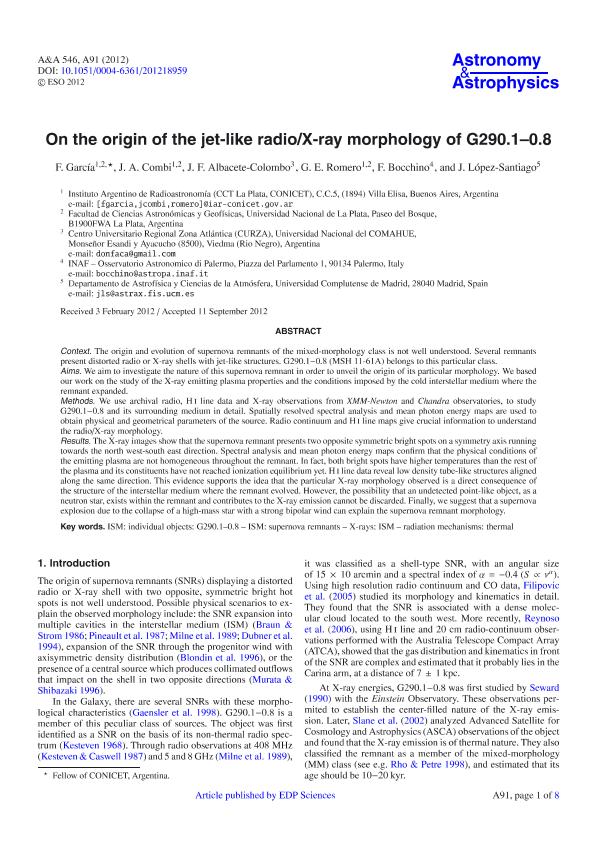Mostrar el registro sencillo del ítem
dc.contributor.author
García, Federico

dc.contributor.author
Combi, Jorge Ariel

dc.contributor.author
Albacete Colombo, Juan Facundo

dc.contributor.author
Bocchino, Fabrizio
dc.contributor.author
López Santiago, Javier
dc.date.available
2022-06-03T13:52:33Z
dc.date.issued
2012-10
dc.identifier.citation
García, Federico; Combi, Jorge Ariel; Albacete Colombo, Juan Facundo; Bocchino, Fabrizio; López Santiago, Javier; On the origin of the jet-like radio/X-ray morphology of G290.1-0.8; EDP Sciences; Astronomy and Astrophysics; 546; 91; 10-2012; 1-8
dc.identifier.issn
0004-6361
dc.identifier.uri
http://hdl.handle.net/11336/158857
dc.description.abstract
Context. The origin and evolution of supernova remnants of the mixed-morphology class is not well understood. Several remnants present distorted radio or X-ray shells with jet-like structures. G290.1-0.8 (MSH 11-61A) belongs to this particular class. Aims. We aim to investigate the nature of this supernova remnant in order to unveil the origin of its particular morphology. We based our work on the study of the X-ray emitting plasma properties and the conditions imposed by the cold interstellar medium where the remnant expanded. Methods. We use archival radio, HI line data and X-ray observations from XMM-Newton and Chandra observatories, to study G290.1-0.8 and its surrounding medium in detail. Spatially resolved spectral analysis and mean photon energy maps are used to obtain physical and geometrical parameters of the source. Radio continuum and HI line maps give crucial information to understand the radio/X-ray morphology. Results. The X-ray images show that the supernova remnant presents two opposite symmetric bright spots on a symmetry axis running towards the north west-south east direction. Spectral analysis and mean photon energy maps confirm that the physical conditions of the emitting plasma are not homogeneous throughout the remnant. In fact, both bright spots have higher temperatures than the rest of the plasma and its constituents have not reached ionization equilibrium yet. HI line data reveal low density tube-like structures aligned along the same direction. This evidence supports the idea that the particular X-ray morphology observed is a direct consequence of the structure of the interstellar medium where the remnant evolved. However, the possibility that an undetected point-like object, as a neutron star, exists within the remnant and contributes to the X-ray emission cannot be discarded. Finally, we suggest that a supernova explosion due to the collapse of a high-mass star with a strong bipolar wind can explain the supernova remnant morphology.
dc.format
application/pdf
dc.language.iso
eng
dc.publisher
EDP Sciences

dc.rights
info:eu-repo/semantics/openAccess
dc.rights.uri
https://creativecommons.org/licenses/by-nc-sa/2.5/ar/
dc.subject
ISM: INDIVIDUAL OBJECTS: G290.1-0.8
dc.subject
ISM: SUPERNOVA REMNANTS
dc.subject
X-RAYS: ISM
dc.subject
RADIATION MECHANISMS: THERMAL
dc.subject.classification
Astronomía

dc.subject.classification
Ciencias Físicas

dc.subject.classification
CIENCIAS NATURALES Y EXACTAS

dc.title
On the origin of the jet-like radio/X-ray morphology of G290.1-0.8
dc.type
info:eu-repo/semantics/article
dc.type
info:ar-repo/semantics/artículo
dc.type
info:eu-repo/semantics/publishedVersion
dc.date.updated
2022-05-06T15:37:33Z
dc.journal.volume
546
dc.journal.number
91
dc.journal.pagination
1-8
dc.journal.pais
Francia

dc.journal.ciudad
Paris
dc.description.fil
Fil: García, Federico. Provincia de Buenos Aires. Gobernación. Comisión de Investigaciones Científicas. Instituto Argentino de Radioastronomía. Consejo Nacional de Investigaciones Científicas y Técnicas. Centro Científico Tecnológico Conicet - La Plata. Instituto Argentino de Radioastronomía; Argentina
dc.description.fil
Fil: Combi, Jorge Ariel. Provincia de Buenos Aires. Gobernación. Comisión de Investigaciones Científicas. Instituto Argentino de Radioastronomía. Consejo Nacional de Investigaciones Científicas y Técnicas. Centro Científico Tecnológico Conicet - La Plata. Instituto Argentino de Radioastronomía; Argentina
dc.description.fil
Fil: Albacete Colombo, Juan Facundo. Universidad Nacional del Comahue. Centro Universidad Región Zona Atlántica; Argentina
dc.description.fil
Fil: Bocchino, Fabrizio. Istituto Nazionale di Astrofísica. Osservatorio Astronómico di Palermo; Italia
dc.description.fil
Fil: López Santiago, Javier. Universidad Complutense de Madrid; España
dc.journal.title
Astronomy and Astrophysics

dc.relation.alternativeid
info:eu-repo/semantics/altIdentifier/doi/http://dx.doi.org/10.1051/0004-6361/201218959
dc.relation.alternativeid
info:eu-repo/semantics/altIdentifier/url/https://www.aanda.org/articles/aa/full_html/2012/10/aa18959-12/aa18959-12.html
Archivos asociados
